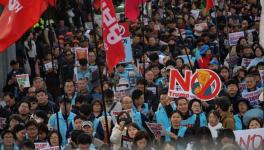How Trump’s Return Will Impact India

Image Courtesy: Flickr
The mainstream media is agog with speculation that Donald Trump’s return to the US presidency will bring about a seismic shift in the global economic and political landscape. While there is no doubt that Trump’s policies will differ from Joe Biden’s in some respects, the fundamental drivers of US domestic and foreign policy remain consistent. These are shaped by two key factors: first, the actual distribution of strategic power in the international political economy; and second, how the US ruling class and its government perceive this distribution.
A core strategic inclination of the US ruling class and its government is as follows: it is neither feasible nor sustainable for the US to simultaneously engage in full-scale strategic competition with China and Russia. Moreover, there is little likelihood that the strategic alignment between China and Russia will weaken in any significant way. Consequently, the US must recalibrate its approach, prioritising the challenge posed by China while relatively disengaging from other strategic rivals, such as Russia, to consolidate resources for this primary geopolitical contest. This broad strategic calculus remains largely intact despite the limited gains the US has made in West Asia.
The attitude of the Us government toward India or any other country is likely to be decisively determined by this fundamental inclination to concentrate strategic resources against China. Therefore, any government in the US is likely to aspire to prevent the strategic crevice between China and India from being pared.
Apart from this, there are other implications of the policies that a Trump presidency is likely to adopt in the US. These policies are likely to result, other things remaining the same, in heightened financial instability, shrinking export demand and import disruptions, and restrictions on emigration of Indians to US, aggravation of adverse climate change, challenges to strategic autonomy etc. This article examines the likely consequences for India of the policies of the Trump presidency, and what policy (and political) changes can enable India to deal with these challenges.
Heightened Financial Instability
The Trump presidency is cognisant of the threat to the reserve currency status of the US dollar from the BRICS countries in the medium to long term. One way to try and ward off this threat is to set the policy rate of interest in the US sufficiently high.
Capital outflows from countries like India can occur when US interest rates rise, as higher returns attract investors to US assets. To mitigate these outflows, India might consider raising its interest rate. However, increasing domestic interest rates can dampen investment, output, and employment due to higher borrowing costs. If the policy rate is not adjusted sufficiently, continued capital outflows may lead to further depreciation of the Indian rupee.
Given India’s relatively inelastic import demand, a weaker rupee can increase the cost of imports, contributing to higher domestic inflation. This scenario can erode real wages and further suppress domestic economic activity. Therefore, in the absence of effective capital controls, both raising and maintaining the current policy interest rate in response to US rate hikes can have contractionary effects on India’s economy.
Trade Disruption
The US manufacturing sector has faced challenges in maintaining its competitive edge, particularly against countries like China. In response, successive US administrations have implemented import tariffs and export controls to protect domestic industries and address strategic concerns.
Some of India’s key export sectors—textiles, pharmaceuticals, and information technology services—are vulnerable to these US trade policies.
• Textiles: The Indian textile industry employs approximately 45 million workers, many from rural and unorganised sectors. Increased US import tariffs could reduce demand for Indian textiles, adversely affecting this significant workforce.
• Information Technology (IT) Services: While tariffs may not directly impact IT services, other protectionist measures, such as stricter H-1B visa regulations, could increase operational costs and hinder growth for Indian IT firms reliant on the US market. Notably, over 80% of India’s IT export earnings come from the US, highlighting the sector’s vulnerability to changes in US trade and immigration policies.
• Pharmaceuticals: As a key supplier of generic drugs to the US, India’s pharmaceutical sector could face non-tariff barriers, including heightened regulatory scrutiny, potentially restricting market access and jeopardising employment within the industry.
Recent developments indicate an escalation in US trade protectionism. On February 1, 2025, President Donald Trump imposed tariffs of 25% on imports from Canada and Mexico, and 10% on imports from China, dubiously citing national security concerns. While India was not directly targeted in this round, the administration has criticised countries like India for their own tariff practices, suggesting potential future trade tensions.
Export controls on technology by the US, aimed at revitalising domestic manufacturing, could also impede technological advancement in countries like India. These controls may limit access to advanced technologies, affecting India’s efforts to climb the technological ladder.
In summary, India’s major export sectors must navigate the challenges posed by evolving US trade policies, which may include increased tariffs, stricter immigration controls, and export restrictions on critical technologies.
Challenges to Emigration of Indians
Immigration has been a cornerstone of India’s economic relationship with the US. Trump’s anti-immigration policies, now underpinned by Project 2025, threaten to adversely impact skilled migration, remittances, and social mobility.
The anticipated restrictions on H-1B and L-1 visas under a Trump presidency are expected to disproportionately impact Indian IT professionals, who constitute a large fraction of these visa holders. By tightening eligibility criteria and increasing visa fees, the administration ostensibly aims to curb the inflow of skilled foreign workers to benefit American high-skilled labour. However, if fully implemented, such measures could also negatively affect the profitability of major US corporations that rely on this workforce. As a consequence, these policies will lead to greater wage differentials between Indian skilled workers in the US and their American counterparts.
Beyond the economic impact on businesses, these restrictive immigration policies will limit both the scale and quality of Indian migrant worker engagement in the US, while also undermining the revenues of Indian IT firms that depend on overseas deployment.
The aggressive enforcement of anti-immigration laws will further disrupt the lives of many Indians in the US, potentially forcing some to return to India. The Indian government’s muted response to these developments seems to reflect a strategic calculation—prioritising the interests of Indian IT firms, which facilitate much of the skilled labour migration to the US, at the expense of less-skilled Indian immigrants who face heightened vulnerabilities.
Additionally, restrictive measures on family-based immigration pathways will lead to family separations, exacerbating financial and emotional distress for Indian worker households. A decline in remittances from Indian workers in the US, whether due to wage suppression, reduced immigration, or a combination of both, will disproportionately affect rural India.
Given that remittances are a vital source of income for many households, supporting essential needs, such as education and small-scale investments, any contraction in these financial flows could deepen economic hardship in these communities.
Aggravation of Adverse Climate Change
The Trump presidency’s rollback of climate commitments and the deregulation of fossil fuel industries will have a devastating impact on global efforts to combat adverse climate change. For India, this will enhance the occurrence of extreme weather events with adverse impacts on vulnerable communities (who are not a priority of the Indian government) and crop yields.
This twin adversity will exacerbate rural urban migration. Given the paucity of urban infrastructure due to decades of attenuated public investment, this will mostly geographically redistribute climate vulnerability of communities. Moreover, if crop yields fall secularly then this will undermining domestic food security, which will involve a decline in food sovereignty.
Challenges to Strategic Autonomy
If the Trump presidency seeks to concentrate strategic resources against China, then the role of India will become significant in determining the outcome of this US quest. However, the strategic autonomy of India will be undermined if the Indian government degrades it's relations with other countries, such as China, Russia, Iran etc in order to placate Trump.
It is becoming increasingly evident that for India, the US cannot be a substitute for China (as a supplier of capital goods, source of technology), Russia (as a supplier of defence equipment, oil etc.), Iran (as a potential supplier of oil, gateway to Central Asia and Russia via a land corridor) etc.
Residual illusions about the ostensible ability of the Indian government to manoeuvre between the two parties – Democrats and Republicans -- in the US must not be a guide to policy. Experience over time has amply demonstrated that decisions regarding foreign policy in the US, as we argued previously, are driven by a basic adherence to a quest to try to prolong the imperialist hegemony of the US.
Lobbying by foreign governments only changes the mode of communication of this quest. In fact, the predatory pronouncements of Trump regarding the “allies” of the US demonstrate at one level the inability of the US to make significant concessions given the contemporary array of strategic power in international political economy. Rather, Trump’s effort, like Biden’s, is to strategically squeeze it's “allies”.
Other Consequences
The cascading effects of export market disruption and financial instability will be most visible in India’s labour market. Industries, such as textiles, leather, and agriculture, which rely heavily on exports to the US, will face lay-offs and production cuts. Workers in these sectors, many of whom belong to marginalised communities such as Dalits, adivasis, women and rural migrants, will struggle to find alternative employment.
Simultaneously, the decline in remittance inflows from Indian workers in the US will add further pressure on rural households, many of which depend on this income for basic needs such as education, healthcare, and housing.
Beyond economic impacts, Trump’s policies are likely to deepen systemic inequalities within India. Shrinking exports, rising inflation, and declining remittances will push more households into poverty. Inflationary pressures, especially on fuel and food prices, will hit low-income families hardest, as they already spend a large share of their income on necessities.
Meanwhile, reduced government revenues from slower economic growth will limit funding for critical poverty alleviation programmes, such as rural employment schemes and subsidised healthcare, further marginalising vulnerable populations.
Women and marginalised castes will bear the brunt of these economic shocks. Women, particularly in low-wage export-driven sectors, like textiles, face a higher risk of job losses, pushing many into informal work or out of the labour force altogether, widening gender disparities. Similarly, Dalits and adivasis, who are often in precarious jobs, will experience heightened economic insecurity, reinforcing caste-based inequalities.
How Can India Deal With the Fallout?
In response to the challenges posed by the Trump administration’s policies, India should assert its strategic autonomy in foreign policy. This involves recognising the US’s strategic challenges in simultaneously contending with China and Russia and understanding the implications for India’s own foreign relations. Embracing an independent foreign policy is not just an option but the optimal path forward.
Diversification of Economic Partnerships
India must diversify its technological sources and export destinations beyond the US. This includes strengthening trade ties with countries in Asia, Africa, and Latin America, while ensuring that no single nation or group holds excessive strategic leverage over India. Such diversification enhances economic resilience and reduces dependency on any one country.
Enhancing Domestic Production and Consumption
Reorienting production toward the domestic market can bolster economic stability. Policies aimed at increasing the incomes of the working population, such as expanded employment guarantee programmes and a broader public distribution system, can stimulate demand for domestically produced goods. This approach not only supports local industries but also promotes universal healthcare, affordable housing, and ecological sustainability.
Strategic Participation in Global Production Networks
India’s involvement in global production networks should be strategic, considering factors like ecological impact, livelihoods, and strategic autonomy. While labour cost advantages are a factor, other elements such as infrastructure and domestic demand are crucial. Investing in public research and development can facilitate technological advancement, enabling Indian firms to move up the value chain in global production.
Climate Resilience and Sustainable Practices
In light of global climate challenges, India should focus on building climate resilience. This includes promoting the cultivation of climate-resilient crops like millets (by expanding public procurement), investing in climate mitigation infrastructure, and redesigning employment programs to support environmental sustainability. Additionally, forming international coalitions with like-minded countries can help coordinate the green transition and address global climate issues effectively.
Conclusion
Addressing the adverse effects of US policies requires India to adopt a multifaceted strategy that emphasises strategic autonomy, economic diversification, domestic capacity building, and climate resilience ensuring inclusion at every stage. Implementing these measures will strengthen India’s position on the global stage and ensure sustainable development.
Shirin Akhter is Associate Professor at Zakir Husain Delhi College, University of Delhi. C Saratchand is Professor, Department of Economics, Satyawati College, University of Delhi. The views are personal.
Get the latest reports & analysis with people's perspective on Protests, movements & deep analytical videos, discussions of the current affairs in your Telegram app. Subscribe to NewsClick's Telegram channel & get Real-Time updates on stories, as they get published on our website.
























